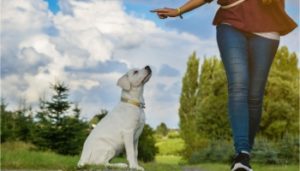
Determining the age of any dog has always been a tricky business. The main problem is the fact that dogs neither know nor care about the concept of the calendar. Therefore, when you buy or adopt a new Lab, the age of the dog will often be unknown or uncertain.
So, how do you tell a dog’s true age? The truth is that it isn’t always possible. However, you can look for the signs of aging and figure out an approximate number.
If you find yourself in a situation like this, and you need to figure out the approximate age of a Labrador, read on. We will show you a step-by-step process that will allow you to make the best possible guess as to the age of your new canine.
The Process
For the purposes of this article, we will assume that you are dealing with a dog whose history is a complete unknown. If you need a story, let’s say it’s a street dog that you adopted.
Step One: Look For Obvious Cues
If you are dealing with a very old dog, you can usually figure it out right away. First of all, they tend to be a lot less active. Old dogs tend to lay around a lot, and they don’t often move around as well as their younger counterparts. Of course, injuries can also cause a dog to be slower or less agile. You can test mobility by trying to get the dog to run around and play. You may have to reward them in some way. A younger dog will usually be more than happy to bound around and run in circles, while older dogs will be a lot more reserved and will usually do a lot less running and jumping.
You should also take a look to see if the dog has any large patches of gray or white hair. Obviously, this wouldn’t mean anything on a dog that is normally gray or white. However, in the case of a Labrador, gray or white will probably stand out on all but the lightest of yellow Labs. Gray or white hair is also a cue that you are dealing with a senior dog. Other signs of advanced aging include tooth decay, clouded eyes, irritability, hearing loss, occasional confusion, and incontinence.
Of course, you will know if the dog is a puppy, so there is no need to talk about identification on that one. The only thing I might mention is that you should know at least something about the breed before declaring for sure. After all, there are some very small breeds of dog out there who could easily be mistaken for a pup from a larger breed.
Now we come to the next point. Before you can even begin to ascertain the approximate age of your dog, you have to verify the breed. Don’t trust your eyes alone because there are many breeds that look similar. Before trying to figure out the age of your Lab, you should make sure that it is, in fact, a Labrador. Since we have already talked about the unique characteristics of the Labrador, I will simply give you a short list of things to look for:
- Flattened tail
- Love of water
- Short, straight coat with two distinct layers
- Square head
- Short muzzle
- Ears never stand up
- No white fur except possibly a small chest patch
If your dog doesn’t match with any of the qualities on this list, it may either be a mixed-breed dog or perhaps even an entirely different breed. If this is the case, I would recommend that you go ahead and fork out some money so that you can have a DNA test done. It may cost a little bit, but it’s the only way to know 100% for sure.
Step Two: Look at the size of their teeth
This step is mainly intended for younger dogs. For older dogs, you would be looking for signs of obvious tooth decay, but it’s a little riskier to look at an old dog’s teeth because many of them are cranky and may bite.
If you have a puppy on your hands, and it has no teeth, you are dealing with a difficult case because the pup will be less than two weeks old. This means that you will have to buy some dog formula. It also means that you will basically have to play mother to this dog, feeding it frequently and keeping it warm if necessary. If the teeth are just beginning to come in, you are looking at a pup that is 3-5 weeks of age. A fully developed set of teeth on a puppy tells you that it is at least eight weeks old.
Step Three: Determine if the dog has adult or baby teeth
This part of the process really isn’t that hard. Determining the state of the pup’s teeth is vitally important because dogs, like ourselves, grow baby teeth at a young age which are later shed and discarded. However, the process happens much more quickly for dogs, since their baby teeth come in at the age of 5 weeks (roughly), and fall out when the dog is 4-5 months old. This means that a dog will only have baby teeth for 3-4 months of its life. Any dog that is not an obvious puppy can, therefore, be assumed to have adult teeth. The important thing to remember is this: Adult teeth tell you for certain that the dog is at least four months old.
You can narrow it down even further by looking at which teeth have come in and which teeth haven’t. When the adult teeth begin to come in, they will almost always start at the front of the mouth. The front incisors will be the first to arrive, followed by the canines, and from there they will work their way back with the rear teeth coming in last. This process takes about four months, so you can use the distribution of their teeth as a way to narrow it down more exactly. For instance, if the dog only has adult teeth in the front, it’s four months old. If the dog has both front incisors and canines, that’s probably closer to five months old. If the back teeth are coming in, a probable age would be 8-10 months.
Step Four: Determine if the dog is full-grown
Since you already know the breed of your dog (probably a Labrador in this case, or at least a Lab mix), you now understand roughly what the dog should look like. Puppies and young adolescents will often have large heads that seem awkward and disproportionate. Their legs will also seem to be too short for the rest of their body. Of course, size is the largest factor here in determining whether or not your dog is full-grown. Dogs generally attain their full height at one year of age, so this gives you a benchmark to accurately determine if the dog is more or less than one year old.
For a Labrador, the accepted height range for a full-grown dog is 22.5 to 24.5 inches tall for males, and 21.5 to 23.5 inches tall for females. Unlike a human, a dog’s height is not measured from the top of their head. Instead, you measure the height of a dog at the withers, which is a point on the back just between the shoulder blades. Why is it done this way? I’m not sure, but I think it mostly comes down to tradition.
Step Five: Look for signs of puberty
From about 6 to 12 months, dogs will go through puberty much as humans do. One of the most obvious signs (as you might guess) is acne. With dogs, an acne problem is much harder to see because of the fur (obviously), but you can still find the little pimples and zits if you look for them. Just gently use your fingers to part the hair and look at the skin in various places. Of course, a skin problem doesn’t automatically put a dog into this age category, but it definitely points in that direction. If your dog is suffering from a case of demodectic skin mange (common for pubescent dogs), go to the pharmacy and get some plain sulfur. Mix it with dog shampoo and rub it on the afflicted area. They won’t chew it because the sulfur tastes horrible, and it isn’t dangerous to their health anyway, at least not in such a small quantity. More importantly, sulfur will kill the bacteria that are responsible for the infection.
Another sign of puberty in dogs is a decreased level of dependence upon their parent or master. As the dog begins to mature, they feel more confident and more ready to go out on their own. A dog that runs ahead of you rather than staying at your side is one sign that the dog has reached puberty. For an unknown dog, this lack of dependence tells you that the dog is likely to be at least five months old.
As a general rule, any young dog with aggression issues can safely be assumed to be at least nine months of age. This is the age at which all dogs, especially males, tend to become more aggressive and more likely to strike if they feel threatened. As with humans, this irritability is a natural part of puberty.
Step Six: Look at their musculature
As stated before, a dog usually reaches full height by the age of one year. By the end of their second year, they have probably grown a lot in terms of musculature as well. Obviously, this will vary by breed, as some breeds naturally tend to be strong and muscular while others do not. Nevertheless, you will be able to notice a certain “filling out” of a dog’s physique during their second year of life.
But right now, you might be wondering how you can actually use this information. Well, here’s what I recommend. Spend a little bit of time looking at pictures of various dogs. Try to stick with dogs whose exact age is known. Take a look at the differences that are visible between a one-year-old dog and a two-year-old dog. You will notice that the two-year-old dog is noticeably more beefy and full-built than the younger one. This is a trait that you can look for when determining age, as it indicates an age of about two years.
Step Seven: Check for gray hair
This is yet another sign of aging that dogs share in common with humans. As they age, some of their hair tends to turn white or gray. Luckily for them, they don’t go bald, as many humans do! Most of the time, this graying or whitening will begin around the area of the muzzle and spread backward. The progression of this graying can also be used as an aging yardstick. A dog will normally get their first touches of muzzle gray at about three years of age. However, be aware that this is not an absolute factor. The rate of graying is not completely consistent from one dog to another, so it only gives us an approximate measurement. In general, though, the amount of gray hair on the muzzle is an indicator of how old they are. If you are dealing with a dog with very noticeable muzzle gray, the dog is probably at least five years old. Dogs that only have a light touch of gray can be assumed to be 3-4 years old.
Step Eight: Check Their Mobility
We talked about this earlier, but we will now go into it in greater depth. At about the age of six or seven, older dogs will often begin to develop mobility problems. At this age, they will become noticeably more sluggish and will probably sleep a little more often than they did before. However, this isn’t a conclusive sign because some dogs are just lazy. A better thing is to find some way to motivate the dog into an active mode. Take their favorite treat and offer it to them, then pull it back. Tease them like this a couple more times, until you can tell that they are getting excited. Now get up and make them chase you a little bit. Hold the treat up high and see if they will jump for it. Put it on a couch or chair and see if they will jump up quickly to get it. If you see a lot of hesitation on their part, or if they refuse to jump at all, they are probably not feeling able to do so. This means that they are likely to be 6-7 years of age.
If you really want to go all-out, try to get the dog to jump through a hoop. This may not work well for very large breeds, but for smaller dogs, it gives you an accurate test. Old dogs generally won’t jump through hoops, although they might kind of run through if you hold it down low enough! Remember, don’t push an old dog too far, or they might injure themselves.
Step Nine: Check their eyes
At seven years of age, it is perfectly normal for a dog to experience some clouding of the eye. This is usually accompanied by a slight loss of vision. As bad as this clouding of the eyes may be, it is a normal thing. Because it usually happens to a dog in their seventh year of life, it gives us a way to identify a dog that is older than seven. However, you should be aware that a multitude of diseases and health conditions that can also cause a clouding of the eye. When you see a cloudy eye, don’t jump to conclusions and assume that the dog is a senior citizen. A dog of seven years or more will have other obvious signs of aging that you can easily spot.
A Word Of Caution:
Be aware that all of these numbers are estimates. As far as I am aware, there is no way to detect the age of a dog in a way that is 100% scientifically accurate. Also, most of the physical signs of age can be mimicked by certain diseases and conditions. However, common sense and common knowledge should tell you all that you need to know since your dog doesn’t particularly care how old they are!
Related Questions
Isn’t there a more exact way to determine a dog’s age?
There is no way to get an exact number that will be 100% reliable. However, any Veterinarian can do a blood profile by testing a sample of your dog’s blood. This will give you the most exact numbers that science can presently offer.
How can I protect my dog from aging symptoms?
Brushing your dog’s teeth is a good idea since the teeth are usually the first things to go. A good diet will also do a lot to extend their health into old age.
Can a dog get tooth implants to compensate for tooth decay?
The answer to this one is very simple: You can do it, but it isn’t cheap. However, these procedures are safe and effective for those who can afford them.



